|
In
a 2005 interview with Florida Golf Magazine, Jim Fazio said in
regard to Mr. Trump, “It was so much fun to build this course
because the owner never asked, were we spending too much money.
He always asked, ‘Do you need anything else?’ Those
were his words every time he came out. Working for a guy like
that is fun, because he doesn't stifle the creative process.”
On the original
18 holes at Trump International, which is most often referred
to as the ‘Championship Course’, Jim took a relatively
flat piece of land and by moving over 3 million cubic yards of
dirt, and bringing in over 5000 trees, shaped Trump International
into an exquisite 7,350 yard golf course with phenomenal elevated
tees and water features. The results are spectacular.
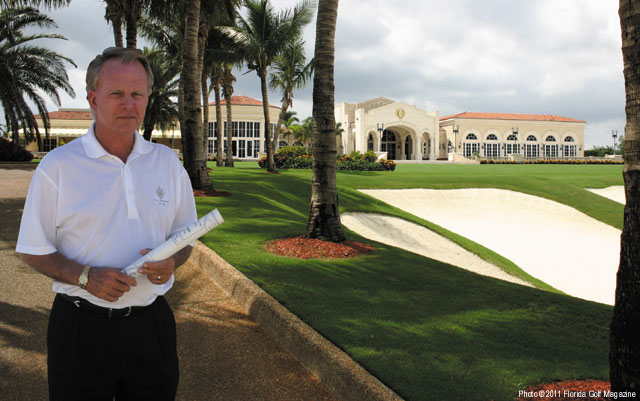
Golf Course Architect Jim
Fazio, seen here next to the 18th Green in front of the Trump
International Clubhouse.
“The
whole project,” Jim explained “which took over two
years to do, was probably the most fun I ever had building a
golf course. I never really thought about the pressure I was
under to build a great golf course. Using too much money never
entered my mind until a couple years after it was finished. Trump
really put me under the gun by giving me that much money and
saying, ‘Give me the best that you can do’, and, ‘How
good is it going to be?’”
Jim continued
by saying, “My uncle, George Fazio, used to say, ‘Never
worry about anything, just work through it and keep going.’
So we just worked every hole, every angle and looked at it every
day for a solid year after we moved the dirt and the trees. So
if there were any changes to be made, we made them while we were
there, when it was easy to see it right away. As far as I'm concerned,
I don't know how it could have turned out any better. Nor do
I know how we could have spent any more money without making
it look gaudy.”
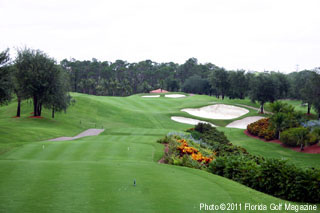
The back tees of the 413 yard, par
four 14th green at TIGC |
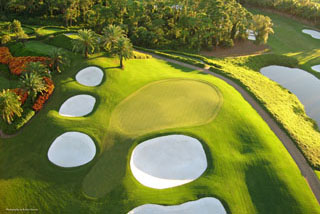
An aerial view of the green complex
14th Hole at TIGC |
“With the
trees, creeks and the rocks and the tinkling sound of the water,”
said Jim, “I've never heard anyone say anything negative
about it, or that it's too hard. There's always a place to play
golf. If there's water on one side of the fairway there's always
another place to go. You don't have to airmail the ball over
a lake unless you missed something. The angles are always there,
to play the golf course and keep the ball going forward, even
if it's on the ground.”
Jim offered another
insight into the course’ design, saying, “Something
else that lots of people really like about Trump International
is that it is very playable. It's rated hard from the back tees,
but it's not rated hard from the front tees. The golfers may
not know that, but they do know that they enjoy it.”
“One of
the things that helped make this course so good was that we started
with a clean slate and were allowed to do almost anything we
wanted,” Jim cheerfully acknowledged. “After deciding
the routing, we moved over 3 million cubic yards of dirt using
a rough grading plan. We never did a final finish plan at the
start of the project, so the finishing features of every hole
were decided on, and built on the job as we went along. Designing
as we went along, deciding on one feature at a time, is what
made the golf holes so unique, because we could do anything we
wanted to them while we were building them. We weren't stuck
doing anything because of a finish plan.”
3 million cubic yards
of dirt were moved building the 1st 18 holes.
 “We were able to move so much dirt because Donald Trump
was the owner,” admitted Jim. “It’s nice when
the owner says, ‘Do you need more dirt? Do you need more
trees? Do you need more pipe?’ He was willing to do anything
it took to make this a spectacular course. A lot of times I had
to tell him, ‘no we don't need any more of this, we don't
need any more of that. Too much of one thing may be too much.’”
“We were able to move so much dirt because Donald Trump
was the owner,” admitted Jim. “It’s nice when
the owner says, ‘Do you need more dirt? Do you need more
trees? Do you need more pipe?’ He was willing to do anything
it took to make this a spectacular course. A lot of times I had
to tell him, ‘no we don't need any more of this, we don't
need any more of that. Too much of one thing may be too much.’”
“As a result”,
said Jim, “We have a blend of everything we needed. We have
rock features, water features, and they flow throughout the whole
golf course so you’re never really surprised when you see
something else, because you saw a little taste of it on this
hole and another little bit of it on that hole. That's what really
makes a golf course blend and flow like this. There are no real
surprises, and also it all looks natural because of the hills
and slopes that we have.”
“We started
the job,” he continued, “and it took us one year just
to transplant 5,000 trees, move 3 million tons of dirt and build
the lake system. The Department of Environmental Resources (ERM)
told us we could only clear 50 acres at a time. It was sketched
out into seven sections. We had to go in and label all the trees
and move what we could. What we knocked down, we had to mitigate.
We also relocated over 60 Gopher Tortoises. It was a long drawn
out process, the longest one I've ever been involved in.”
“We started
building the golf course after that,” Jim explained. “I
was actually in charge of the shaping and finish grading on that
project. I was there every day with my son, Jim, who was operating
the dozer and doing the detailing after we got it roughed in.
Together, we actually built all the greens, bunkers and tees.
That's how that golf course was built, day by day.”
Jim was patient,
yet very enthusiastic as he continued with his description of
the day by day endeavor. “Then we had to figure out where
we were going to put all the water features. One of the hardest
parts was building the water feature at #17. It took nine months
and cost 2.5 million dollars, with all the work we had to do
around it, and on the feature itself.”
The foundation of
2.5 million dollar water feature on #17 at TIGC
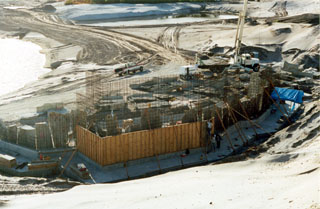 “The
next hardest job,” exclaimed Jim Fazio, “was building
the cart paths, trying to hide them between mounds and getting
the concrete trucks up these hills. We had a special dozer we
rented just to pull the concrete trucks in and pull them out.
The concrete we used had Chattahoochie stone aggregate and was
twice as expensive as normal concrete. Plain old concrete wasn't
good enough for Mr. Trump.” “The
next hardest job,” exclaimed Jim Fazio, “was building
the cart paths, trying to hide them between mounds and getting
the concrete trucks up these hills. We had a special dozer we
rented just to pull the concrete trucks in and pull them out.
The concrete we used had Chattahoochie stone aggregate and was
twice as expensive as normal concrete. Plain old concrete wasn't
good enough for Mr. Trump.”
The trees are
magnificent on this course, and Jim also gave us some background
about them. “We bought and moved 1,000 oak trees from out
near Lake Okeechobee. It took us five months to move them all
in. These were 20 to 40 ft. oak trees. They had to wrap them,
and they could only haul three of them at a time. The landscaper
would bring them in and drill a hole in them and pick them up
to place them. I would place each tree after the hole was shaped.
This way we got our tree lined fairways. We stuck some trees
out in the corners for targets for shot angles and stuff like
that.”
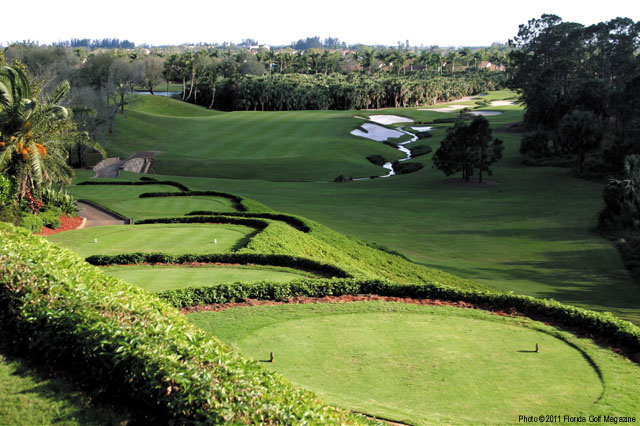
The View atop the highest
of nine elevated tees, 5 stories above the split fairway of the
550 yard, par five 15th Hole. Play the tee shot left of the creek
and the lay-up right of the creek. Accuracy is important on the
approach shot into the shallow, sloping green.
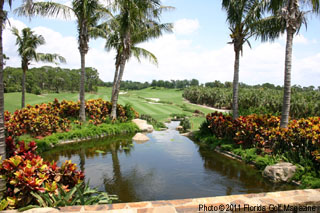 Pictured
at left is the view, looking back at the fairway from the bridge
next to the 15th green. Pictured
at left is the view, looking back at the fairway from the bridge
next to the 15th green.
“Working
with the trees was very painstaking,” explained Jim. “Then,
we bought more than a thousand royal palms to line the outside
of the property. We lined the driving range with them, and around
the clubhouse to give it that formal stately look. We didn't
use them on the golf course, because to me they don't look natural.
We also bought 1,000 coconut trees. Coconut trees go great on
the golf course. They hang over the lake. They hang over the
tees. Things like that make it kind of neat. Like when you go
up the cart path on 17, you’re going through a coconut trail.”
Fazio conceded,
“I know we spent 2 million dollars on the little plants
that give the place color. That's a lot of plants. There's so
much variety and color in the plants, lakes, streams, creeks
and waterfalls, people spend time on taking pictures and forget
to play, because they've never seen anything like this in Florida.
The golf course by itself probably cost 8 million. And the water
features and the trees cost another 8 million. I would say without
the clubhouse we spent 25 million. I know he (Mr. Trump) always
says everything cost 40 million, but I'd guess it cost a little
more than that.
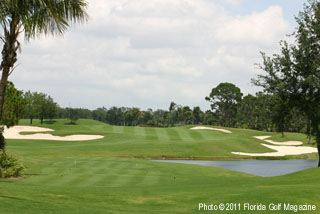
The back tees of the 413 yard par
four, 16th Hole at TIGC. |
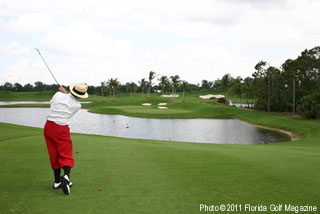
Dr. Gary Wiren hits an approach
to TIGC’s difficult 16th Hole. |
Jim Fazio concluded
his description of Trump International Golf Club by giving his
assessment of the finishing holes. “The three closing holes,
16, 17 and 18, are really great golf holes," he said. "During
the LPGA tournaments, depending on the wind, they were always
two out of three of the toughest holes on the golf course throughout
the tournament. Three days out of four, one year, the 16th hole
was the toughest, because the wind changes and there are water
hazards there, and the wind is what really affects play for golf
pros. If there is no wind they will eat you up. The wind is the
equalizer for the golf pro. You start thinking about the three
closing holes when you're on 13. You want to be three up by the
time you get to the 16th tee, so you don't lose the match.”
Pictured below: Five stories
above the 18th fairway, the back tees measure 469 yards on the
par four, 18th Hole at Trump International Golf Club. Two golfcarts
and golfers can be seen in the distance on generous forward tees.
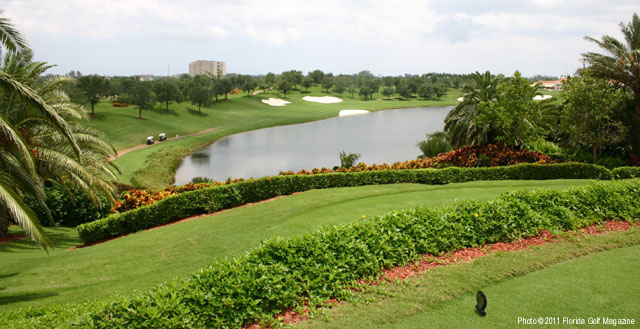
|